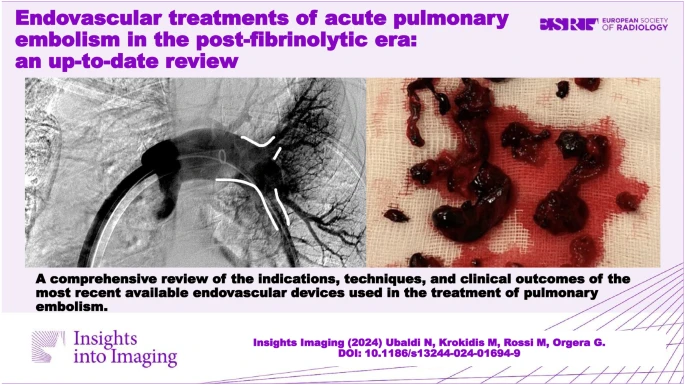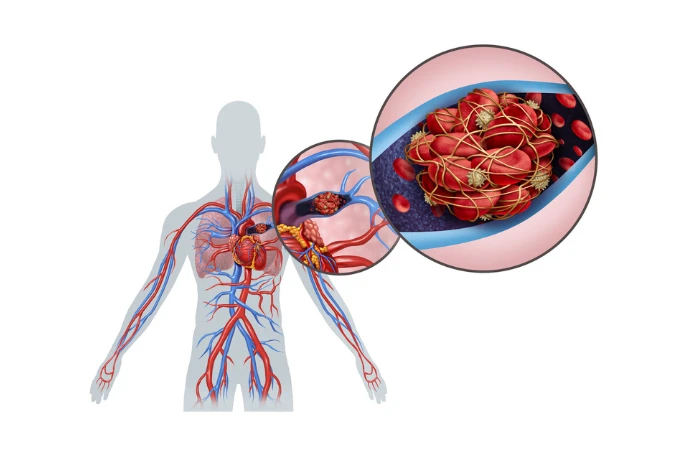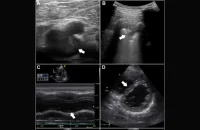Pulmonary embolism (PE) poses a significant threat to global cardiovascular health, with treatment strategies for intermediate and high-risk cases remaining contentious due to the delicate balance between maintaining hemodynamic stability and minimising bleeding risks. While systemic thrombolysis has traditionally been the go-to option, its efficacy is inconsistent, and it carries substantial bleeding risks. Alternative interventional treatments such as catheter-directed lysis (CDL) and aspiration thrombectomy have emerged, but their optimal use is still uncertain. Recent advancements in endovascular devices show promise in improving hemodynamic stability, potentially extending their use to prevent instability in less severe cases. However, ongoing trials are necessary to evaluate their efficacy and impact on mortality. A recent review published in Insights into Imaging provides a comprehensive update on catheter-directed therapies for PE, particularly focusing on mechanical thrombectomy techniques, and assesses their safety and efficacy in comparison to conventional treatments. The relevance of this review lies in its thorough coverage of indications, techniques, and outcomes associated with novel endovascular devices for PE treatment. Key points highlighted include the effectiveness of mechanical thrombectomy, the preventive potential of aspiration devices against hemodynamic deterioration, and the role of catheter-directed therapy in reducing bleeding complications.
Risk Assessment and Treatment Strategies for Pulmonary Embolism
Pulmonary embolism (PE) ranks as the third leading cause of cardiovascular-related mortality globally. Early risk assessment is crucial for appropriate treatment. PE is categorised into high risk (massive), intermediate risk (segmental), and low risk (subsegmental) based on severity. In-hospital mortality for intermediate-risk PE is around 2.9%, with a 30-day mortality of 15%. However, post-discharge mortality persists, often due to lack of aggressive treatment beyond anticoagulation. Imaging, particularly computed tomography venography, guides treatment planning. According to ESC guidelines, anticoagulation is the primary treatment for intermediate-risk PE, with systemic thrombolysis and catheter-directed therapy (CDT) reserved for those deteriorating to hemodynamic instability. CDT includes both catheter-directed thrombolysis and aspiration thrombectomy. For high-risk PE, systemic thrombolysis and anticoagulation are immediate options, with CDT considered if thrombolysis fails or is contraindicated. Thrombolysis reduces mortality but increases bleeding risk, prompting exploration of alternatives like CDL. Lower-dose thrombolytics in CDL minimise bleeding risk while enhancing drug efficacy. CDL improves pulmonary blood flow and right ventricular function, but lacks strong evidence compared to systemic thrombolysis. CDL is considered when systemic thrombolysis fails, is contraindicated, or when patients deteriorate despite anticoagulation. This review focuses on recent literature regarding CDT, encompassing both CDL and mechanical thrombectomy devices, with emphasis on novel aspiration techniques.
Catheter-directed lysis: Advancements, Trials, and Considerations
Catheter-directed lysis (CDL) encompasses conventional CDL (cCDL) and ultrasound-assisted CDL (USCDL), with USCDL being the focus due to its stronger evidence base and frequent use. USCDL ensures direct application of low-dose thrombolytic drugs to the thrombus, minimising systemic bleeding risk and maximising efficacy compared to systemic thrombolysis. The technique involves the use of EkoSonic MACH4e Endovascular Systems, featuring micro-ultrasound devices and intelligent drug delivery catheters. These devices allow precise clot targeting, enhanced thrombolysis with ultrasound, and reduced systemic bleeding risk. Despite advantages such as improved recanalisation rates and reduced catheter-related complications, USCDL has limitations including longer procedure times and the need for closely monitored settings.
The ULTIMA trial demonstrated the superiority of USCDL over anticoagulation alone in reversing right ventricular (RV) dilatation without increased bleeding complications. Similarly, the CANARY trial showed significantly lower RV/LV ratios and composite mortality rates with CDL compared to anticoagulation alone. However, the SUNSET sPE trial did not find advantages of USCDL over CDL in intermediate PE management.
Prospective clinical trials like PERFECT and SEATTLE II reported promising results with CDL in high-risk PE patients, including stabilisation of hemodynamic status and improved survival without major safety concerns. The OPTALYSE PE trial explored using the lowest possible dose of rt-PA release from CDL to minimise the risk of intracranial haemorrhage, showing potential for faster mechanical thrombectomy procedures while maintaining safety and efficacy.
Comparative studies between CDL and systemic thrombolysis have shown lower mortality rates and reduced bleeding events with CDL, emphasising the need for randomised trials to evaluate safety and efficacy and identify patients who would benefit most from CDL.

Image Credit: Insights into Imaging
Advancements in Mechanical Thrombectomy for Pulmonary Embolism
Recent advancements in thrombectomy technologies have led to the development of large-bore endovascular aspiration catheters, designed to rapidly remove proximal thrombi and alleviate right ventricular (RV) strain in pulmonary embolism (PE) patients. Clinical studies on these devices have demonstrated lower incidence of major bleeding and mortality, significant reduction in RV dysfunction and pulmonary artery pressure, and shorter stays in intensive care units. This review focuses on discussing the most studied products in this category.
The INARI FlowTriever© system utilises a large-bore guide catheter and nitinol expanding system to engage and extract thrombi. Clinical trials like FLARE and FLAME have reported improvements in RV/LV ratio and significant reductions in mortality with this system. Ongoing trials like PEERLESS aim to further evaluate its efficacy in PE treatment.
The AngioVac© system, while primarily designed for venous thrombi removal, has also been used for PE treatment. However, its effectiveness in PE remains uncertain due to limited evidence and technical challenges such as incomplete thrombus evacuation.
The INDIGO© system, particularly the Penumbra Indigo aspiration systems, has shown promise in reducing RV/LV ratio and intraprocedural pulmonary artery pressure. Trials like EXTRACT-PE and STRIKE-PE have demonstrated significant clinical improvements with this system, paving the way for further research and development.
Future perspectives in mechanical thrombectomy for PE include ongoing randomised controlled trials (RCTs) comparing aspiration catheters to other therapies and investigating long-term outcomes and associations with chronic thromboembolic pulmonary hypertension. Despite the evolving landscape, integrating this evidence into individualised care pathways for acute PE patients remains a challenge.
Systemic thrombolysis, while commonly used, may not sufficiently reduce mortality and is associated with significant side effects like intracranial haemorrhage (ICH). Aspiration thrombectomy has emerged as a promising alternative, offering rapid clinical improvement with lower risk of hemorrhagic complications. Several single-arm studies and interim randomised controlled trial (RCTs) results support its efficacy and safety. While we haven't yet transitioned to a post-fibrinolytic era, the availability of effective alternatives underscores the need for considering various management options for these patients. In conclusion, endovascular aspiration devices have demonstrated efficacy and safety in treating intermediate and high-risk PE. Further research, including reproducible case-series studies and RCTs comparing these devices with other methods, is crucial in this rapidly evolving field. Future randomised trials comparing different aspiration techniques will be necessary if their beneficial properties continue to be confirmed.
Source: Insights into Imaging
Image Credit: iStock








